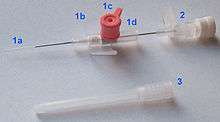Peripheral venous catheter

1. The catheter itself is composed of (a) a tip for insertion into the vein, (b) wings for manual handling and securing the catheter with adhesives, (c) a valve to allow injection of drugs with a syringe, (d) an end which allows connection to an intravenous infusion line, and capping in between uses.
2. The needle (partially retracted) which serves only as a guidewire for inserting the cannula.
3. The protection cap which normally covers the needle's tip.
In medicine, a peripheral venous catheter (PVC), peripheral venous line or peripheral venous access catheter is a catheter (small, flexible tube) placed into a peripheral vein in order to administer medication or fluids. Upon insertion, the line can be used to draw blood.
The catheter is introduced into the vein by a needle (similar to blood drawing), which is subsequently removed while the small tube of the cannula remains in place. The catheter is then fixed by taping it to the patient's skin (unless there is allergy to adhesives). Newer catheters have been equipped with additional safety features to avoid needlestick injuries. Modern catheters consist of synthetic polymers such as teflon (hence the often used term 'Venflon' or 'Cathlon' for these venous catheters). In 1950 they consisted of PVC plastic.[1] [2] [3]
A peripheral venous catheter is the most commonly used vascular access in medicine. It is given to most emergency room and surgical patients, and before some radiological imaging techniques using radiocontrast, for example. In the United States, more than 25 million patients get a peripheral venous line each year.[4]
A peripheral venous catheter is usually placed in a vein on the hand or arm. It should be distinguished from a central venous catheter which is inserted in a central vein (usually in the internal jugular vein of the neck or the subclavian vein of the chest), or an arterial catheter which can be placed in a peripheral as well as a central artery. In children, a local anaesthetic gel (such as lidocaine) is applied to the insertion site to facilitate placement.
Complications
Insertion of a venous cannula is a painful procedure that can lead to anxiety and stress. Use of a vapocoolant immediately before cannulation reduces pain during the procedure, without increasing the difficulty of cannulation.[5] Infection, phlebitis, extravasation, infiltration, air embolism, hemorrhage (bleeding) and formation of a hematoma (bruise) may occur.
Because of the risk of insertion-site infection the CDC advises in their guideline that the catheter needs to be replaced every 96 hours.[6] Although these catheters can best not be left in place longer than necessary, the need to replace these catheters routinely is debated.[7] Expert management has been shown to reduce the complications of peripheral lines.[4][8]
Additional images
-

Placement of a cannula in progress. The first steps are the same as for drawing blood.
-

Just before inserting.
-

The catheter in between uses.
-

Newer catheter with additional safety features.
References
- ↑ Massa DJ; Lundy JS; Faulconer A, Jr; Ridley RW (5 Jul 1950). "A plastic needle.". Proc Staff Meet Mayo Clin. 25 (14): 413–415. PMID 15430460.
- ↑ Rivera AM, Strauss KW, Van Zundert A, Mortier E (2005). "The history of peripheral intravenous catheters : How little plastic tubes revolutionized medicine". Acta Anaesthesiol. Belg.
- ↑ Strauss KW, Onia R, Van Zundert A (August 2008). "Peripheral intravenous catheter use in Europe: Towards the use of safety devices". Acta Anaesthesiologica Scandinavica. 52 (6): 798–804. doi:10.1111/j.1399-6576.2008.01664.x. PMID 18477072.
- 1 2 Soifer NE, Borzak S, Edlin BR, Weinstein RA (March 1998). "Prevention of peripheral venous catheter complications with an intravenous therapy team: a randomized controlled trial". Arch. Intern. Med. 158 (5): 473–7. doi:10.1001/archinte.158.5.473. PMID 9508225.
- ↑ Griffith, Rebecca J; Jordan, Vanessa; Herd, David; Reed, Peter W; Dalziel, Stuart R (26 April 2016). "Vapocoolants (cold spray) for pain treatment during intravenous cannulation". Cochrane Database of Systematic Reviews. John Wiley & Sons, Ltd. doi:10.1002/14651858.cd009484.pub2. Retrieved 29 April 2016.
- ↑ CDC Morbidity and Mortality Weekly Report Aug 2002. "Guidelines for the Prevention of Intravascular Catheter-Related Infections". Retrieved 2008-03-13.
- ↑ Bregenzer T, Conen D, Sakmann P, Widmer AF (January 1998). "Is routine replacement of peripheral intravenous catheters necessary?". Arch. Intern. Med. 158 (2): 151–6. doi:10.1001/archinte.158.2.151. PMID 9448553.
- ↑ Miller JM, Goetz AM, Squier C, Muder RR (1996). "Reduction in nosocomial intravenous device-related bacteremias after institution of an intravenous therapy team". J Intraven Nurs. 19 (2): 103–6. PMID 8852171.
External links
- National Cancer Institute: peripheral venous catheter
- Recommended practices for the insertion and management of peripheral intravenous catheters (PIVC)